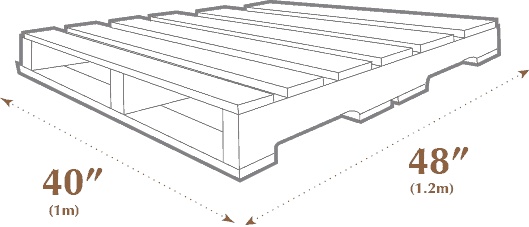
In Freight business or ordering freight services, you might have come across the term, standard pallet size. Charges of shipping might depend on them and the question is pretty basic. However, there isn’t much information that gives you the right idea when you are palletizing your items for a freight shipping or ordering a reefer container. People spend millions and billions globally on freight services but ambiguity regarding pallet size does not seem right.
What is the Average Pallet Size?
STANDARD PALLET SIZE IS 48″x 40″
Well, the above-mentioned line has answered your question right. There is no need to scroll any further. But let me tell you that’s also a generic answer and you might find the sizing variation in your state or region. It’s better to get a proper understanding so you can ask the right questions before booking and shipment and your experience won’t be disappointing.
Moving on from 48″ x 40″ which is the most common size, the next one is 48″ x 48″. In different states, the standard size can vary and many global warehouses operate at a larger standard pallet. Palletization often depends on the merchandise and dimensions of the product and having 48″ benefits the company in the long run.
How many pallets can be shipped in a truck?
″2 standard-sized pallets can fit side by side in the truck″
If you are booking less-than-truckload shipping, you need to know about the standard pallet sizing and how many pallets can be accommodated in the truck. Most trucking companies like Zorka’s use trucks that are approximately 96″ wide and that is common in LTL shipping. Talking about the 40″ wide standard pallets, two of them can be fitted side by side and the less conventional 48″ can also be loaded with the truck’s compatible dimensions.
For normal shipments, 2 types of freight containers are mostly used; 53-feet ones and in some situations 48-feet ones.Fot the first type total of 52 pallets can be accommodated in one container as long as the pallets are double-stacked. For goods with double-stack warnings, 26 single pallets can be transported at one time. You can increase the number by 2 pallets by going with pin-wheeling but majority of receivers won’t have forklifts that can handle pin-wheeling. So going with regular 26 pallets would be the wise option
With the above-mentioned calculations, you can easily guess how many pallets can be accommodated in different size containers or reefer vans. For example, the 53-foot truck can hold up to 30 pallets (standard size= 48″ x 40″) and 16 feet mini-trailer can transport six standard. With proper dimensions, you can figure out the truckload easily.
Pallets: Material used and where to find them?
In general, the pallets are made from either plastic or wood depending on the merchandise but wood pallets are more common. As compared to wood, plastic pallets are more durable but acquiring them can get expensive. Considering all the conditions like bumping, loading, and unloading via forklift, and being left stranded in warehouses for a long period, people often go with the cheaper option which is wood. Wooden pallets are easy to acquire and once their life cycle is over, vendors can recycle them.
Acquiring the pallets is fairly easy. All you got to do is contact any pallet manufacturer and you can enjoy good rates on bulk orders. These vendors can be found all over the country. Smart business owners recycle pallets a lot. Unload one shipment and repack the pallet with other stuff and pallets can be used in a continuous cycle. Pallets are meant to hold heavy weights so during manufacturing they are made with the clear mind of not delivering one or two shipments.
Pallet sizes are not fixed and you can have them custom-built as well if your product is not suitable for a standard size. However, you should also keep in mind that you might not transport the same number of pallets as compared to a standard size if the dimensions are off even by a few inches. Always keep in mind that transport companies like Zorka’s have standard LTL containers so you should order the pallets according to the shipping requirements

